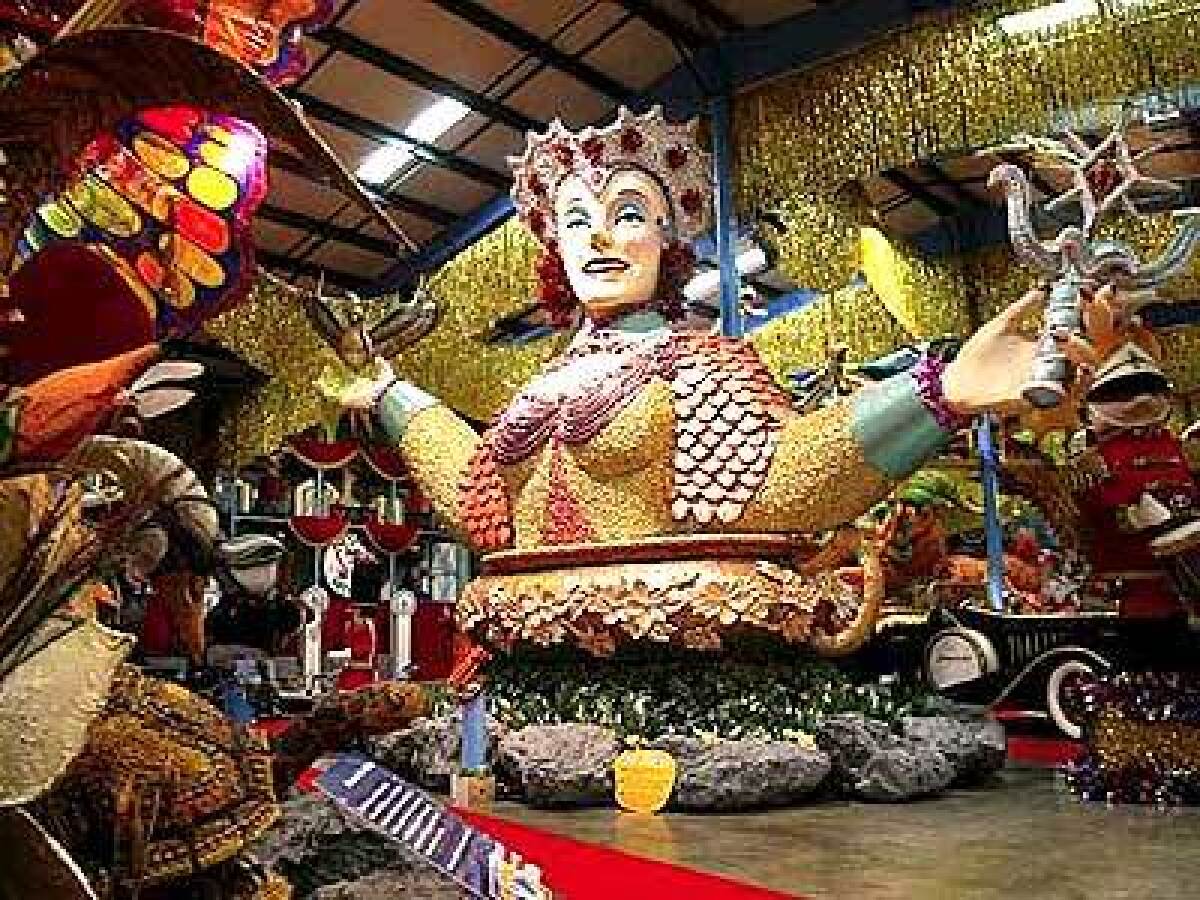Museum keeps parade memories afloat

- Share via
Shenandoah Caverns, Va — For a few brief hours, the Rose Parade floats delight millions around the world who tune in or turn out to see the floral spectacles. Then many of those floats are destroyed.
But not all.
In this small town in Virginia’s Shenandoah Valley just 100 miles west of Washington, float builder Earl C. Hargrove Jr. has opened one of the state’s fastest-growing tourist attractions: an airplane hangar-size showcase for award-winning parade floats, many of them from the Rose Parade. He calls it American Celebration on Parade, and this 43,000-square-foot space is a fantastical realm of giant singing ducks, playful bears, stately eagles and fearsome dragons.
The fragile flowers that once decorated the floats -- Rose Parade floats must use only natural materials -- are gone. They have been replaced with traditional float-building materials such as “petal paper,” thin, fluttery strips of paper that are true to the original colors.
On a visit here last month, I was told that all but three of the 27 floats on display were from Pasadena’s annual New Year’s Day fest. (The exhibit may vary because some of the floats are rented out to other parades.)
Here I found “All Aboard,” a showmanship trophy winner at the 1994 Rose Parade that even in semi-retirement still dazzles. This faithful reproduction of an Old West train is decked out in vivid red, blue and gold and includes a steam engine that stands two stories tall. With a coal car and a passenger car, it stretches 100 feet. It takes three people to operate it. It rolled again in President Clinton’s second inaugural parade in 1997 and in three Philadelphia Thanksgiving Day parades.
Hargrove, 74, is no stranger to the float business. He and his father before him have constructed floats for every presidential inaugural parade since Harry S. Truman’s in 1949. For some parades he builds 30 or more, and he also decorates inaugural ballrooms. His pride in his profession prompted him to open American Celebration in July 2000. It features some of his own historic inaugural floats.
“Most parades pass by quickly. This is a chance to linger and appreciate the talent and imagination that produce these works of art,” he says of the museum, which is next to another popular attraction he owns, Shenandoah Caverns.
A Rose Parade fan, Hargrove typically buys parts of those floats to display at American Celebration or to incorporate in his own works. He gets them from Phoenix Decorating Co. of Pasadena, one of the largest Rose Parade float builders. A complete float and its cross-country move can cost as much as $50,000, says Marvin Bond, director of marketing for Hargrove Inc. of Lanham, Md., Hargrove’s float-building company.
As a parade lover and three-time Rose Parade veteran, I wandered eagerly among the floats. I felt as though I was witnessing an ongoing parade -- except that I was moving and the floats were standing still. I read signs detailing their history.
The elephant had been bedecked in red chrysanthemums for the 2001 Rose Parade. Red petal paper replaced the blooms.
Nearby, I activated a family of giant polar bears, trophy award winners in the 1998 Rose Parade. One husky fellow shook his head, and two others rolled about on a simulated Alaskan ice floe. Once they were clothed in white flowers; now white fur adorns them.
Among his own floats, Hargrove is perhaps proudest of a huge American flag, 63 feet long and 24 feet tall. The flag, perched atop a farm wagon hidden from view, is made of red, white and blue hand-stapled puffs of satin using 1 million staples. It was supposed to appear in President Reagan’s second inaugural parade in 1985, but the procession was canceled because of bitter cold. When a special ceremony for parade participants moved indoors, the flag went inside as the backdrop on the stage. It subsequently marched in the inaugural of the first President Bush in 1989.
James T. Yenckel is a Washington, D.C.-based travel writer.
More to Read
Sign up for The Wild
We’ll help you find the best places to hike, bike and run, as well as the perfect silent spots for meditation and yoga.
You may occasionally receive promotional content from the Los Angeles Times.





